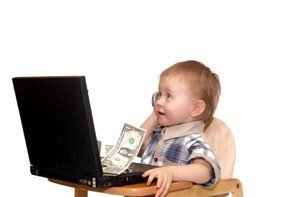In a time when materialism is at a high, the task of teaching children the value of a dollar becomes difficult. Someone recently told me, "What you teach your children in the first ten years of their lives is what molds them into the people they become." I've given this a great deal of thought, and I've decided that I want my son to be a man who understands the value of the things he owns. I want him to prioritize his spending, and I want him to be a responsible consumer. He's going to start with baby steps, but he's going to start down that ten year path of learning the meaning behind the paper in his pocket.
To begin with, we're trying to teach an abstract concept to a mind that isn't prepared for the abstract. Start with more concrete associations with even the youngest children: trade. For example, it's snack time and you have three crackers with cheese and your toddler has pretzels. She wants the crackers. Instead of giving in, trade the pretzels for two crackers. This basic system teaches her how people get things, and it also teaches that things often come with a price. (Then go ahead and give her a few pretzels back after the lesson; after all she's only a toddler.)
Another way to teach value is to teach a limit. For every new toy, an old toy must be donated, or he/she may only choose one thing to purchase at the store. This will help children to learn that there are limits; we run out of money; we run out of space. We also need to help them to become aware of the value they hold on items. This helps in the long term when spending limits come into question, and it helps short term when children feel the need to have everything in sight; something taught by commercials.
Once children understand that items are purchased with money and that there are limits to their money and their purchases, it's time to teach them cost. My son has the basic concept of money, but he has no idea of price. He knows expensive versus inexpensive, but he thinks cars cost $900 (to him a great deal since his bank only holds $5).
The easiest way to do this is to take children to the store and let them take an active role in buying the family's groceries. Try playing a game at home which takes items from around the home and labels them with appropriate costs. Then, hand out play money to your children and have them "buy" what they can. Even some of their video games teach how to buy items with money accrued through gaming; use this interest to your advantage and make a lesson out of it.
Another way to teach the lesson of cost is to give your children allowances. If my son goes to the store with an aunt or grandparent, I send two or three dollars with him. He's limited to spending only his money. Quickly he has learned that he can't afford everything, he can be satisfied with something small, and that he can buy three smaller items for his money rather than one larger item. He's slowly learning the value of those three dollars.
Explain the tricks of advertising and pricing to children early. When shopping, point out the problems with "two for" deals. (Rather than buying one item at $2.50, the "two for" deal persuades consumers to buy two items for $5.) Also point out bad sales, those that mark items down a dollar or two and label them as clearance. Note that because an item is marked as "on sale" that doesn't mean it's a great deal.
Rounding is an important consumer mathematical skill. Children see an item marked $2.99 and think of it as costing $2 rather than $3. Explain this concept early; always round up. Think of the big picture. A TV that costs $499 is a $500 TV; that's a big difference from $400.
It's a long road to smart consumerism, but it's a ten year journey. Hopefully the destination is worth the trip.

Add your voice! Click below to comment. ThriftyFun is powered by your wisdom!
If the child breaks something and it costs to be fixed, or loses it, don't automatically replace it. Example: I bought my teenager a digital camera for her birthday and told her how to take care of it. She left it on the floor and the screen was stepped on.
My daughter is just 2, but already she knows that when we get something from a store, we have to pay for it. I am building upon this, even at such a young age. In cases where she has her own dollar or two, she hands it over for the toy she wants. I make sure to pay for many things in cash, so she will see actual paper money changing hands instead of just the swipe of a check card (which makes it seem like nothing has changed hands at all). My parents helped instill in me the meaning of money and of frugality. I recall, as a child, seeing a large house or a fancy car and commenting to my father, "They must be rich." He would always answer, "Or.... very deeply in debt." Those were lasting lessons in materialism and money, and I'm so thankful for that. It has kept us completely debt free, and helped us on the road to teaching our daughter the same values.
Add your voice! Click below to comment. ThriftyFun is powered by your wisdom!